The Clean: Part 1
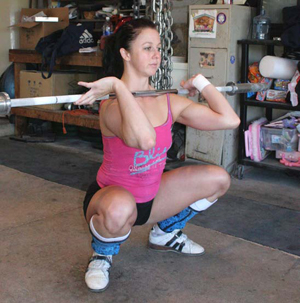
The clean and jerk is a two-part lift, contested after the snatch in competition. The bar is lifted first to the shoulders and then driven overhead. Because of this segmentation and the stronger body positions, lifters are able to handle significantly greater loads in the clean and jerk than in the snatch. For most, the clean and jerk is more easily learned than the snatch, particularly when already familiar with the snatch, but it is not without its own technical subtleties.
The Grip
Grip Width
There is as much variation among lifters in terms of grip width for the clean as there is for the snatch. The grip width in the clean is more likely to be naturally adjusted to best suit the lifter than in the snatch. This adjustment should be allowed to occur unimpeded until it negatively affects the lift, at which time the coach and athlete should consider the grip placement more critically and attempt to establish a consistent and sound width.
A basic starting point for width is as narrow a hand placement as is possible without the arms interfering with the legs. In other words, when in the starting position, the grip should be such that the protruding knees do not touch the arms, or do so only very lightly. This will place the hands slightly outside shoulder width, which will be convenient for the rack and subsequent jerk.
Some lifters, particularly those who toe out dramatically and whose knees consequently flare during the pull, will have the arms actually bending somewhat around the legs in the starting position, straightening soon after the barbell leaves the platform. This is not necessarily problematic for an experienced lifter, but it should be avoided initially by new lifters as one more potential difficulty.
The Hook Grip
As in the snatch, the hook grip is used in the pulling segment of the clean. Unlike in the snatch, the hook is invariably released as the barbell reaches its destination on the shoulders. Although some athletes will have the particular anthropometrics in addition to the flexibility needed to rack a barbell on the shoulders with a hook grip, it is neither necessary nor helpful. The release of the grip will be discussed further in later sections.
The Front Squat
The receiving position of the clean is the front squat, in which the bar is racked securely on the lifter’s shoulders. Security in this position with a heavy barbell demands excellent positioning just as the overhead squat does. The torso must be as upright as possible, the shoulders pushed forward and upward somewhat to provide a solid resting place for the bar, and the elbows must be high.
What’s critical for the novice athlete to understand is that the barbell is absolutely not supported by the hands and arms. The weight is supported by the shoulders and upper chest—the hands merely hold it in position there. The grip on the bar must be loose—a tight grip will nearly invariably result in lowered elbows and a bar shifting forward to be supported by the arms. No matter how strong an athlete is, the arms simply cannot support maximal loads in the front squat. The habit should never be allowed to develop.
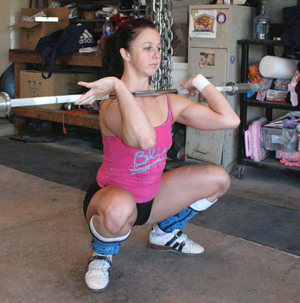
In the front squat, the bar is supported by the shoulders, not the hands
and arms. The elbows must be held high and the hands kept loose.
The barbell position for many is extremely uncomfortable because of the pressure it places against the throat. The unfortunate nature of the position is that the bar rests against the throat. This problem can be mitigated if not eliminated by pulling the head and neck back. How much pressure it places on each lifter varies from unnoticeable to enough to bring him or her to unconsciousness during exertion. The latter group must be extraordinarily diligent with their bar placement and head and neck positioning—passing out underneath a front squat is ill-advised.
Because the barbell should be resting on the shoulders, it should be possible for the lifter to remove his or her hands from the bar without any disruption of the squat. Squatting with the bar on the shoulders and the arms pointed straight ahead will demonstrate to the athlete the necessity of the high elbow position as well as the fact that the hands are not needed to secure the bar.
The actual position of the hands and fingers during the squat will vary among lifters along with their arm segment lengths and flexibility. Some lifters will be able to comfortably keep the hands under the bar as deep as the junction of fingers to palm, whereas others may be able to keep only the tips of the first fingers under the bar. Either position or anything in between is acceptable, although the latter athletes will be faced with a little more trouble repositioning in preparation for the subsequent jerk.
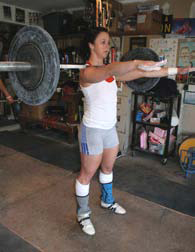
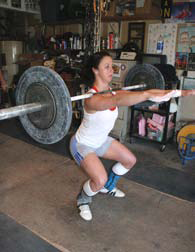
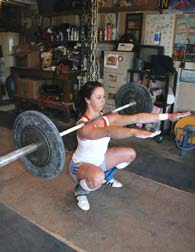
The Frankenstein Squat clearly demonstrates to the athlete that the bar is not held in place by the hands, but by the elevation of the arms,
accomplished with high elbows in the rack position.
The Feet: Pulling and Receiving
The foot positions in the clean are identical to their counterparts in the snatch. In the pulling position, the feet are under the hips, and the receiving position is that of the athlete’s squat. Commonly new lifters will unconsciously place the feet significantly wider when receiving the clean than they will for the snatch or squat. This is usually due to one of two things: Athletes who learn to power clean as training for other sports often change the depth of their hips to receive the bar by widening the stance in addition to bending the knees, being either afraid or not strong enough to catch with more leg bend. The other reason is that a wide foot placement and shallower squat depth can temporarily compensate for inadequate flexibility preventing a full-depth front squat with an appropriately upright torso.
Regardless of the reason for the inconsistent receiving positions, this should be discouraged as soon as it is recognized to avoid the formation of habits more difficult to correct later. A quick way to help a lifter correct the problem is to place chalk lines on the platform along the outsides of his or her feet when in the expected squat stance. Without interfering with the movement of the clean itself, this is often enough of a reminder that it will with repetition result in more consistently correct foot placement.
The Burgener Warm-up
At this point, the athlete is at least reasonably familiar with the snatch. Aside from the width of the grip, the first and second pulls of the snatch and clean are essentially identical—that is, the motion of the legs, hips and back are the same. To save time, we may at this point simply tell the athlete to clean with no further instruction—lift the bar from the knees to the rack position—and see what happens. Often enough, he or she will do this well and we can proceed. In the cases in which it is not done well, we can return to the Burgener Warmup, modified for the clean.
The Burgener Warm-up for the clean differs only in the width of the hand placement and the final location of the bar, that is the shoulders instead of overhead. Because few athletes will have the wrist and elbow flexibility to rack a length of PVC on the shoulders, it’s often easier to use at least a light training bar.
Section 1
As it is for the snatch, the first section of the Burgener Warm-up is the simplest but likely the most critical. Instruct the athlete to stand with the feet in the pulling position with his or her PVC held with a clean grip hanging at arm’s length. The athlete will simply dip by bending only the knees and drive up again, following with a shrug of the shoulders. At this stage, the arms remain straight, but do not allow the athlete to lock them forcefully—they should simply be hanging. The elbows should be rotated outward so they face to each side—this will ensure that the bar remains close to the body during the third pull. You can also allow the athlete to drop the bar to around mid-thigh in order to include the scoop in the drill.
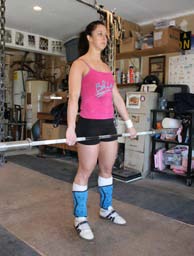
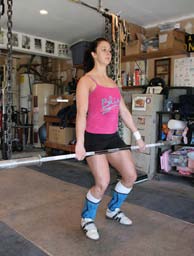
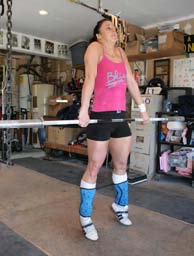
section 1
Section 2
The next section will begin with the first section and continue to a scarecrow position. After completing the dip and shrug of section 1, instruct the athlete to elevate the elbows, keeping the bar against the body. Ensure that the arms do not bend until the hip and knee extension and shrug have occurred. Do not allow the lifter to raise the hands higher than the elbows. Because the grip placement is narrower for the clean than the snatch, the bar will hit the lifter on the thighs instead of in the crease of the hips. This increases the possibility of bouncing the bar out from the body as the knees scoop—keep a close eye on this and make sure the lifter continues to keep the bar close to the body.
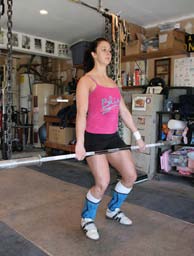
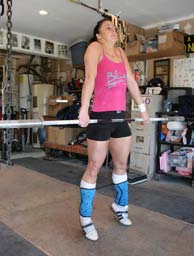
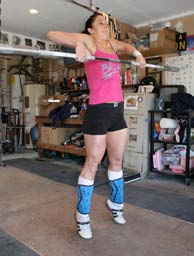
section 2
Section 3
The third section is the muscle clean exercise, essentially a clean without the athlete pulling him- or herself under the bar—there is no re-bending of the knees as the bar arrives in the rack position. Instead, the athlete will imitate the third pull by lifting the bar to the rack position. After successively performing the movements of sections 1 and 2, the athlete will finish the movement by bringing the elbows around the bar and slipping the bar smoothly onto the shoulders. It’s important to ensure at this early stage that the lifter understands and puts into practice the idea of meeting the bar—that is, he or she must bring the shoulders neatly under the bar, not allow the bar to crash down. The muscle clean is an excellent exercise for helping the athlete develop better positional awareness and experience the feeling of a smooth meeting of bar and rack.
Note that the muscle clean is not a reverse curl—the elbows pivot around the bar, not the other way around. For most, the natural tendency is to bring the elbows into the sides, forcing the bar to swing out away from the body on its way to the shoulders. Just as in the snatch, keeping the elbows rotated outward will ensure they stay up and away from the body allowing the bar to remain close. From this high and outside position, they must swing under the bar quickly to arrive at their finishing position, pointing straight ahead or slightly higher.
.jpg)
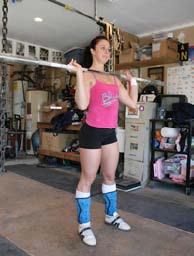
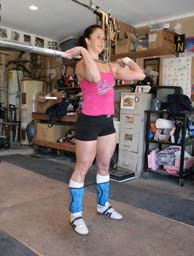
Section 3
Section 4
After performing section 3, the athlete will keep the bar racked. Check for proper positioning. As the athlete did during the pulling and receiving drill, he or she will jump the feet from the pulling to the receiving position as quickly as possible, dropping into as deep of a front squat as he or she is capable of, and recovering to the starting position.
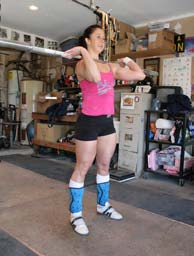
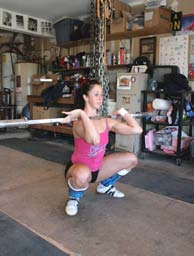
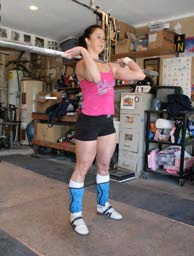
section 4
Section 5
The final section brings together all of the previous. Starting with the feet in the pulling position, the athlete will dip at the knees, extend the knees and hips, shrug, lift the elbows high and outside, and rack the bar on the shoulders as he or she pulls him or herself underneath it to catch in a full squat or one of limited depth if that is the current capacity of the athlete. As always, ensure the bar remains close to the lifter’s body and he or she fully extends the knees and hips.
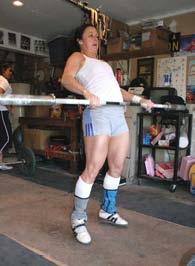
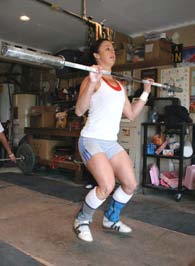
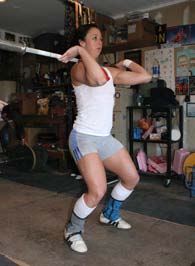
section 5
Same Bat Time, Same Bat Channel
That’s it for now. Next time we graduate to the floor with a real barbell.
The Grip
Grip Width
There is as much variation among lifters in terms of grip width for the clean as there is for the snatch. The grip width in the clean is more likely to be naturally adjusted to best suit the lifter than in the snatch. This adjustment should be allowed to occur unimpeded until it negatively affects the lift, at which time the coach and athlete should consider the grip placement more critically and attempt to establish a consistent and sound width.
A basic starting point for width is as narrow a hand placement as is possible without the arms interfering with the legs. In other words, when in the starting position, the grip should be such that the protruding knees do not touch the arms, or do so only very lightly. This will place the hands slightly outside shoulder width, which will be convenient for the rack and subsequent jerk.
Some lifters, particularly those who toe out dramatically and whose knees consequently flare during the pull, will have the arms actually bending somewhat around the legs in the starting position, straightening soon after the barbell leaves the platform. This is not necessarily problematic for an experienced lifter, but it should be avoided initially by new lifters as one more potential difficulty.
The Hook Grip
As in the snatch, the hook grip is used in the pulling segment of the clean. Unlike in the snatch, the hook is invariably released as the barbell reaches its destination on the shoulders. Although some athletes will have the particular anthropometrics in addition to the flexibility needed to rack a barbell on the shoulders with a hook grip, it is neither necessary nor helpful. The release of the grip will be discussed further in later sections.
The Front Squat
The receiving position of the clean is the front squat, in which the bar is racked securely on the lifter’s shoulders. Security in this position with a heavy barbell demands excellent positioning just as the overhead squat does. The torso must be as upright as possible, the shoulders pushed forward and upward somewhat to provide a solid resting place for the bar, and the elbows must be high.
What’s critical for the novice athlete to understand is that the barbell is absolutely not supported by the hands and arms. The weight is supported by the shoulders and upper chest—the hands merely hold it in position there. The grip on the bar must be loose—a tight grip will nearly invariably result in lowered elbows and a bar shifting forward to be supported by the arms. No matter how strong an athlete is, the arms simply cannot support maximal loads in the front squat. The habit should never be allowed to develop.

In the front squat, the bar is supported by the shoulders, not the hands
and arms. The elbows must be held high and the hands kept loose.
The barbell position for many is extremely uncomfortable because of the pressure it places against the throat. The unfortunate nature of the position is that the bar rests against the throat. This problem can be mitigated if not eliminated by pulling the head and neck back. How much pressure it places on each lifter varies from unnoticeable to enough to bring him or her to unconsciousness during exertion. The latter group must be extraordinarily diligent with their bar placement and head and neck positioning—passing out underneath a front squat is ill-advised.
Because the barbell should be resting on the shoulders, it should be possible for the lifter to remove his or her hands from the bar without any disruption of the squat. Squatting with the bar on the shoulders and the arms pointed straight ahead will demonstrate to the athlete the necessity of the high elbow position as well as the fact that the hands are not needed to secure the bar.
The actual position of the hands and fingers during the squat will vary among lifters along with their arm segment lengths and flexibility. Some lifters will be able to comfortably keep the hands under the bar as deep as the junction of fingers to palm, whereas others may be able to keep only the tips of the first fingers under the bar. Either position or anything in between is acceptable, although the latter athletes will be faced with a little more trouble repositioning in preparation for the subsequent jerk.



The Frankenstein Squat clearly demonstrates to the athlete that the bar is not held in place by the hands, but by the elevation of the arms,
accomplished with high elbows in the rack position.
The Feet: Pulling and Receiving
The foot positions in the clean are identical to their counterparts in the snatch. In the pulling position, the feet are under the hips, and the receiving position is that of the athlete’s squat. Commonly new lifters will unconsciously place the feet significantly wider when receiving the clean than they will for the snatch or squat. This is usually due to one of two things: Athletes who learn to power clean as training for other sports often change the depth of their hips to receive the bar by widening the stance in addition to bending the knees, being either afraid or not strong enough to catch with more leg bend. The other reason is that a wide foot placement and shallower squat depth can temporarily compensate for inadequate flexibility preventing a full-depth front squat with an appropriately upright torso.
Regardless of the reason for the inconsistent receiving positions, this should be discouraged as soon as it is recognized to avoid the formation of habits more difficult to correct later. A quick way to help a lifter correct the problem is to place chalk lines on the platform along the outsides of his or her feet when in the expected squat stance. Without interfering with the movement of the clean itself, this is often enough of a reminder that it will with repetition result in more consistently correct foot placement.
The Burgener Warm-up
At this point, the athlete is at least reasonably familiar with the snatch. Aside from the width of the grip, the first and second pulls of the snatch and clean are essentially identical—that is, the motion of the legs, hips and back are the same. To save time, we may at this point simply tell the athlete to clean with no further instruction—lift the bar from the knees to the rack position—and see what happens. Often enough, he or she will do this well and we can proceed. In the cases in which it is not done well, we can return to the Burgener Warmup, modified for the clean.
The Burgener Warm-up for the clean differs only in the width of the hand placement and the final location of the bar, that is the shoulders instead of overhead. Because few athletes will have the wrist and elbow flexibility to rack a length of PVC on the shoulders, it’s often easier to use at least a light training bar.
Section 1
As it is for the snatch, the first section of the Burgener Warm-up is the simplest but likely the most critical. Instruct the athlete to stand with the feet in the pulling position with his or her PVC held with a clean grip hanging at arm’s length. The athlete will simply dip by bending only the knees and drive up again, following with a shrug of the shoulders. At this stage, the arms remain straight, but do not allow the athlete to lock them forcefully—they should simply be hanging. The elbows should be rotated outward so they face to each side—this will ensure that the bar remains close to the body during the third pull. You can also allow the athlete to drop the bar to around mid-thigh in order to include the scoop in the drill.



section 1
Section 2
The next section will begin with the first section and continue to a scarecrow position. After completing the dip and shrug of section 1, instruct the athlete to elevate the elbows, keeping the bar against the body. Ensure that the arms do not bend until the hip and knee extension and shrug have occurred. Do not allow the lifter to raise the hands higher than the elbows. Because the grip placement is narrower for the clean than the snatch, the bar will hit the lifter on the thighs instead of in the crease of the hips. This increases the possibility of bouncing the bar out from the body as the knees scoop—keep a close eye on this and make sure the lifter continues to keep the bar close to the body.



section 2
Section 3
The third section is the muscle clean exercise, essentially a clean without the athlete pulling him- or herself under the bar—there is no re-bending of the knees as the bar arrives in the rack position. Instead, the athlete will imitate the third pull by lifting the bar to the rack position. After successively performing the movements of sections 1 and 2, the athlete will finish the movement by bringing the elbows around the bar and slipping the bar smoothly onto the shoulders. It’s important to ensure at this early stage that the lifter understands and puts into practice the idea of meeting the bar—that is, he or she must bring the shoulders neatly under the bar, not allow the bar to crash down. The muscle clean is an excellent exercise for helping the athlete develop better positional awareness and experience the feeling of a smooth meeting of bar and rack.
Note that the muscle clean is not a reverse curl—the elbows pivot around the bar, not the other way around. For most, the natural tendency is to bring the elbows into the sides, forcing the bar to swing out away from the body on its way to the shoulders. Just as in the snatch, keeping the elbows rotated outward will ensure they stay up and away from the body allowing the bar to remain close. From this high and outside position, they must swing under the bar quickly to arrive at their finishing position, pointing straight ahead or slightly higher.
.jpg)


Section 3
Section 4
After performing section 3, the athlete will keep the bar racked. Check for proper positioning. As the athlete did during the pulling and receiving drill, he or she will jump the feet from the pulling to the receiving position as quickly as possible, dropping into as deep of a front squat as he or she is capable of, and recovering to the starting position.



section 4
Section 5
The final section brings together all of the previous. Starting with the feet in the pulling position, the athlete will dip at the knees, extend the knees and hips, shrug, lift the elbows high and outside, and rack the bar on the shoulders as he or she pulls him or herself underneath it to catch in a full squat or one of limited depth if that is the current capacity of the athlete. As always, ensure the bar remains close to the lifter’s body and he or she fully extends the knees and hips.



section 5
Same Bat Time, Same Bat Channel
That’s it for now. Next time we graduate to the floor with a real barbell.
| Greg Everett is the owner of Catalyst Athletics, publisher of The Performance Menu Journal and author of Olympic Weightlifting: A Complete Guide for Athletes & Coaches, Olympic Weightlifting for Sports, and The Portable Greg Everett, and is the writer, director, producer, editor, etc of the independent documentary American Weightlifting. Follow him on Facebook here. |
Search Articles
Article Categories
Sort by Author
Sort by Issue & Date
Article Categories
Sort by Author
Sort by Issue & Date

